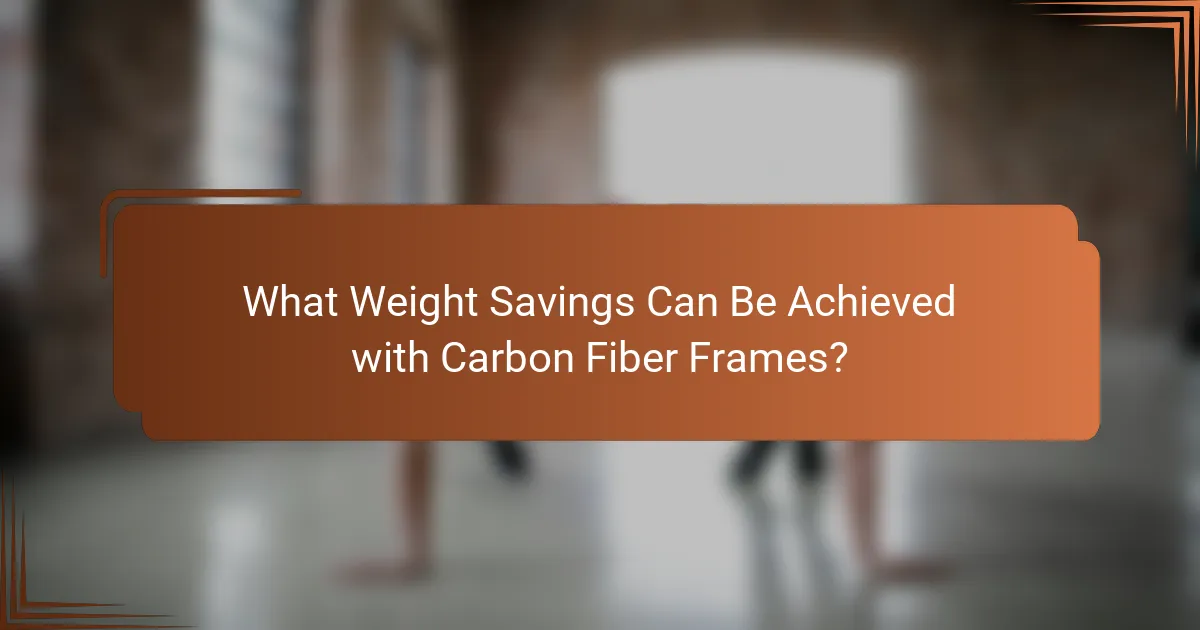High-performance carbon fiber bike frames provide significant advantages for serious cyclists, including enhanced durability and impressive weight savings. These frames are designed for superior strength and comfort, offering a lightweight construction that can reduce weight by up to 30% compared to aluminium. Additionally, they feature advanced design capabilities for improved aerodynamics and tailored stiffness profiles, optimising ride quality. This article explores the benefits, durability, and weight savings of carbon fiber frames, highlighting their appeal for competitive cycling.

What are the Key Benefits of High-Performance Carbon Fiber Bike Frames?
High-performance carbon fiber bike frames offer significant benefits, including superior strength, lightweight construction, and enhanced vibration dampening. These attributes improve overall riding efficiency and comfort.
The frames are known for their durability, resisting corrosion and fatigue over time. Additionally, the weight savings can range from 20% to 30% compared to aluminium frames, allowing for faster acceleration and easier handling.
These frames also provide design flexibility, enabling manufacturers to create aerodynamic shapes that enhance performance. Riders experience improved power transfer due to the stiffness of carbon fiber, which maximises energy output.
Overall, the combination of durability, weight savings, and performance enhancements makes high-performance carbon fiber bike frames an excellent choice for serious cyclists.
How do Carbon Fiber Frames Enhance Riding Experience?
High-performance carbon fiber bike frames enhance the riding experience by providing superior stiffness, reduced weight, and improved vibration dampening. These frames allow for better power transfer, making pedalling more efficient. Their lightweight nature contributes to easier handling and agility on various terrains. Additionally, carbon fiber’s ability to absorb road vibrations results in a smoother ride, reducing fatigue over long distances.
What Performance Metrics Improve with Carbon Fiber?
High-performance carbon fiber bike frames improve metrics such as stiffness-to-weight ratio, aerodynamics, and vibration damping. These metrics enhance overall ride quality and efficiency. The stiffness-to-weight ratio can reach values exceeding 10 Nm/kg, providing superior power transfer. Carbon fiber’s low density contributes to significant weight savings, often reducing frame weight by 20-30% compared to aluminium. Additionally, carbon fiber’s ability to absorb road vibrations leads to increased comfort and reduced fatigue during long rides.
Why Choose Carbon Fiber Over Other Materials?
Carbon fiber offers superior strength and lightweight properties compared to other materials. Its high tensile strength allows for robust bike frames that can withstand significant stress while remaining lightweight. This results in improved performance and efficiency for cyclists. Additionally, carbon fiber’s ability to absorb vibrations enhances ride comfort, making it a preferred choice for high-performance biking. The durability of carbon fiber, resistant to corrosion and fatigue, ensures longevity, providing excellent value over time.

How Does Durability Compare Among Carbon Fiber Bike Frames?
High-performance carbon fiber bike frames are known for their superior durability compared to traditional materials. They typically withstand significant stress and impact, making them ideal for competitive cycling. The durability of these frames results from the high tensile strength of carbon fiber, which can absorb shocks effectively.
In contrast to aluminium or steel frames, carbon fiber offers a unique attribute: it can be engineered to provide specific stiffness and flexibility, enhancing ride quality. While some rare instances of carbon fiber frames may suffer from damage due to extreme conditions, most high-quality options are designed to last for years with proper care.
Overall, carbon fiber bike frames achieve a balance of lightweight design and exceptional durability, making them a preferred choice for serious cyclists.
What Factors Influence the Lifespan of Carbon Fiber Frames?
The lifespan of carbon fiber frames is influenced by factors such as material quality, manufacturing process, and maintenance. High-quality carbon fibers enhance durability, while precise manufacturing ensures structural integrity. Regular maintenance, including inspections for cracks and damage, can significantly extend the frame’s lifespan. Environmental conditions, such as exposure to UV light and moisture, also play a role in longevity.
How Do Environmental Conditions Affect Frame Durability?
Environmental conditions significantly impact the durability of high-performance carbon fiber bike frames. Factors such as temperature fluctuations, humidity, and exposure to UV light can weaken the material over time. For example, extreme temperatures can cause thermal expansion or contraction, leading to micro-cracks. Humidity can promote corrosion in components, while UV exposure can degrade the resin that binds the carbon fibers. Regular maintenance and protective coatings can help mitigate these effects, enhancing frame longevity.

What Weight Savings Can Be Achieved with Carbon Fiber Frames?
Carbon fiber frames can achieve weight savings of 30% to 50% compared to aluminium or steel frames. This significant reduction enhances performance, allowing for faster acceleration and improved handling. For example, a typical carbon fiber frame weighs around 1,000 grams, while a comparable aluminium frame may weigh 1,500 grams. The unique attribute of carbon fiber’s high strength-to-weight ratio contributes to these savings, making it a preferred choice for competitive cyclists. Additionally, the durability of carbon fiber ensures that these lightweight frames can withstand rigorous use without compromising structural integrity.
How Does Frame Weight Impact Overall Performance?
Frame weight significantly influences overall performance by affecting speed, handling, and rider fatigue. Lighter carbon fiber frames enhance acceleration and climbing efficiency, while heavier frames may provide more stability at high speeds. The optimal weight balance maximises performance benefits, allowing riders to maintain endurance without excessive strain.
Which Models Offer the Best Weight-to-Strength Ratios?
High-performance carbon fiber bike frames from brands like Trek, Specialized, and Cannondale offer exceptional weight-to-strength ratios. Trek’s Emonda SLR 9, for example, features a weight of 690 grams and a stiffness-to-weight ratio of 20.5 N/mm. Specialized’s S-Works Tarmac SL7 weighs 800 grams with a stiffness-to-weight ratio of 17.2 N/mm. Cannondale’s SuperSix EVO Hi-MOD comes in at 750 grams, boasting a stiffness-to-weight ratio of 17.5 N/mm. These models exemplify the balance of lightweight construction and durability, making them top choices for performance cyclists.

What Unique Features Set Premium Carbon Fiber Frames Apart?
Premium carbon fiber frames stand out due to their superior strength-to-weight ratio and advanced manufacturing techniques. These features enhance performance and durability. Unique attributes include tailored stiffness profiles, which optimise ride quality and handling. Additionally, some premium frames incorporate integrated components, reducing weight and improving aerodynamics. Rare attributes, such as custom layup schedules, allow for specific rider preferences and performance needs.
How Do Custom Geometries Affect Performance?
Custom geometries enhance performance by optimising aerodynamics, stiffness, and weight distribution in high-performance carbon fiber bike frames. Tailoring frame geometry allows for improved handling and responsiveness, which directly impacts speed and efficiency. For instance, a lower bottom bracket enhances stability during cornering, while slacker head angles improve comfort on long rides. Additionally, unique geometries can reduce drag, making the bike faster on flat terrains. These modifications contribute to a competitive edge in racing and recreational cycling.
What Innovations Are Emerging in Carbon Fiber Technology?
Emerging innovations in carbon fiber technology enhance the performance of high-performance bike frames. Recent advancements focus on improving strength-to-weight ratios, leading to lighter frames without compromising durability. For instance, developments in resin systems and fiber weaving techniques allow for customised stiffness and flexibility. These innovations result in bike frames that are not only lighter but also more resilient, providing cyclists with enhanced speed and handling. Additionally, the integration of smart materials may offer real-time performance monitoring, further advancing cycling technology.

What Rare Attributes Should Cyclists Look for in Carbon Fiber Frames?
Cyclists should look for unique attributes in carbon fiber frames that enhance performance. These may include integrated cable routing for aerodynamics, vibration-damping technologies for smoother rides, and adjustable geometry for personalised fit. Additionally, some frames offer proprietary layup techniques that optimise strength-to-weight ratios, providing a competitive edge.
How Does Limited Edition Craftsmanship Influence Value?
Limited edition craftsmanship significantly enhances the value of high-performance carbon fiber bike frames. This exclusivity attracts collectors and enthusiasts, driving demand and price. Unique designs and advanced manufacturing techniques contribute to their durability and weight savings, making them sought-after in the cycling community. Limited editions often feature rare attributes, such as custom finishes or unique geometries, further elevating their market appeal.
What Specialized Designs Cater to Competitive Cyclists?
High-performance carbon fiber bike frames are designed for competitive cyclists, offering superior benefits in durability and weight savings. These frames typically weigh 30% less than aluminium, enhancing speed and agility. The stiffness-to-weight ratio allows for efficient power transfer, improving overall performance. Advanced manufacturing techniques ensure consistent quality and strength, making them a popular choice among professionals.

What Common Mistakes Should Be Avoided When Choosing Carbon Fiber Frames?
When choosing carbon fiber frames, avoid common mistakes like overlooking frame geometry, ignoring weight limits, and neglecting manufacturer reputation. Proper frame geometry ensures comfort and performance. Each frame has specific weight limits that affect durability. Always research the manufacturer’s reliability to ensure quality.
How Can Proper Maintenance Extend Frame Life?
Proper maintenance can significantly extend the life of high-performance carbon fiber bike frames. Regular inspections and timely repairs prevent wear and tear, maintaining structural integrity. Proper cleaning techniques remove dirt and grime, which can cause damage over time. Additionally, storing the bike in a controlled environment protects it from temperature fluctuations that can weaken the frame. Using appropriate lubricants on moving parts reduces friction, enhancing performance and longevity. Overall, a consistent maintenance routine maximises durability and preserves the lightweight benefits of carbon fiber frames.
What Should Be Considered When Upgrading to a Carbon Fiber Frame?
When upgrading to a carbon fiber frame, consider weight, stiffness, ride quality, and durability. The weight savings of carbon fiber can enhance performance, while its stiffness improves power transfer. Additionally, the ride quality may vary based on frame design. Durability is essential; high-quality carbon frames resist impacts better. Budget also plays a role, as prices can differ significantly based on brand and technology.